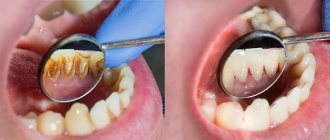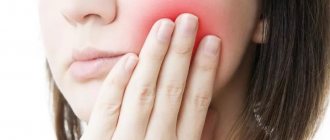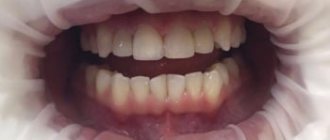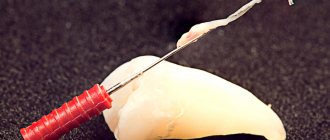31.10.2019
A trip to the dentist does not always end the way you would like. A common situation is when a tooth reacts to exposure to cold after a filling procedure. The reaction of a tooth to cold is a complication that results from the installation of a filling. This material will tell you why this situation occurs and how you can deal with it.
Causes of hypersensitivity
After treatment does the tooth react to cold?
The increased reaction of the tooth to exposure to low temperatures indicates only one thing - the dental nerve is alive, and its reaction is hypersensitive.
This occurs under certain circumstances listed below.
If you have illnesses:
- Pulpitis is an inflammation of the neurovascular bundle. Here the pain is prolonged and can last from a couple of hours to several days.
- Caries is the destruction of hard tooth tissues. In this case, the pain will occur for a short period of time and gradually fade away.
The dentist will carry out the process of installing a filling only after he has eliminated the true cause of the tooth disease.
Tooth structure
The human tooth is quite complex. The crown (the outer protruding part) is covered with enamel, the hardest tissue in the body that protects the tooth from infections and mechanical damage. On the crown, immediately below the enamel, there is dentin - a durable tissue that makes up the bulk of the tooth. Dentin is pierced by dentinal tubules, which, in turn, are connected to the pulp - loose connective tissue in the tooth cavity. The pulp contains a huge number of blood and lymph vessels, many nerve endings that instantly respond to any external influences on the tooth.
Any, even the slightest damage or even thinning of the enamel leads to the fact that the influence of external influences on the pulp and the nerves located in it increases. And a tooth, even at first glance quite healthy, treated and filled, reacts with pain - for example, to hot and cold. This reaction is called hyperesthesia.
Installing a filling after caries treatment as a problem of discomfort
Caries has two degrees of progression: chronic and acute. There are also several forms of dental damage by this pathology: deep, medium and initial.
The dentist treats deep and medium forms of lesions by mechanical treatment of the affected area, followed by installation of a filling.
If during the treatment of the tooth part of the tissue affected by caries was left behind, this may become the root cause of pain when exposed to cold.
In some dental offices, doctors use a special liquid that stains the affected part of the dental tissue with a certain color. This is very convenient, since the dentist can clearly see which area needs to be removed. But not all doctors use this drug.
In a filled tooth, pain can also be caused by other reasons, for example, improper filling procedures for deep caries. The chronic course of caries will be expressed by dense pigmented dentin, in which case the procedure for removing the affected tissue can be stopped, followed by the installation of a filling.
If the dentin is soft, the dentist may decide to strengthen it with a lining containing calcium. In this case, it does not open the tooth cavity. The infection contained in the affected bottom of the cavity gradually penetrates into the dental cavity through the dentinal canals.
Inflammation of the neurovascular bundle, accompanied by pain, is a response to infection.
The occurrence of pulpitis can be provoked by incorrect tactics of the procedure, when in the process of removing tissues affected by caries, sufficient air-water cooling of the tooth tissues was not applied. The consequence of this is heating of the pulp tissue, which provokes the occurrence and development of pulpitis.
Non-systemic reasons
- Exposure to food acids. They are rich in citrus fruits, cabbage of various varieties, radishes, sweet carbonated waters;
- Non-carious lesions of hard dental tissues. Enamel wears off quickly, especially if not properly cared for;
- Development of caries. It provokes erosion of dental tissues or wedge-shaped effects (V-shaped flaw);
- Mechanical tooth destruction. Occurs during strong impacts, bleaching, grinding for subsequent installation of crowns;
- Inflammation of soft dental tissues (pulpitis). The reason is the penetration of infections, mainly bacterial.
Pulpitis as a cause of pain after filling
With this pathology, inflammation of the nerves and blood vessels that are located in the dental tissue occurs.
Its occurrence can be provoked by nervous strain, infection and overheating of the pulp tissue.
Painful sensations after filling again indicate that the procedure was performed incorrectly.
Due to frequent night pain, the tooth is amputated, since the infection penetrates from the crown to the root area.
Another cause of pain is incomplete removal of the neurovascular bundle. There is a possibility that not all canals were found and passed through by the dentist.
The process of treating pulpitis most often extends over several visits to the doctor. In this case, the dentist will place a temporary filling from visit to visit until the treatment process is completed and the permanent filling is installed. If the treatment is delayed, after some time microscopic gaps appear between the temporary filling and the dental tissue, through which irritants (including cold ones) penetrate into the dental cavity, causing pain.
Dangerous post-filling pain
There are often cases when pain after the installation of a filling serves as a signal of a serious problem that can undermine the patient’s health. Such pain does not go away on its own, regardless of whether you treated caries or pulpitis.
Dangerous pain is associated with infection in the tissue and is characterized by:
- increased pain in the treatment area;
- pain when eating and drinking, even if the food is at room temperature;
- increased body temperature, in some cases - fever and chills;
- swelling of the gums;
- severe swelling and redness of the cheek;
- the appearance of a feeling that the tooth is in the way: it is sticking out, ready to fall out;
- tissue necrosis, which causes a putrid odor in the mouth.
If at least one of the above signs appears, you should seek help from a doctor to avoid complications.
Causes of dangerous pain
Diagnostics will help determine the cause that triggered the development of the infection. In this case, it is important to choose a competent dentist, since in most cases it is the inaccuracy of the examination
leads to
incorrect diagnosis
and the appearance of toothaches.
- Medical error (haste, negligence) includes several sub-reasons that prompted the patient to re-visit the dental office (usually in another clinic and with another specialist), treatment and refilling.
So, these reasons include:
- diagnosis without x-ray.
There is a risk that the doctor will not notice serious problems: for example, inflammation that began in the canals even before treatment. As a result, the treatment will be incomplete: caries is treated, but pulpitis and infected canals remain.
- installing a seal without complying with safety requirements.
This procedure will lead to sharp pain as soon as the anesthesia wears off.
- a filling that is too large or small and disrupts the bite.
At the same time, you need to understand that the shrinkage of any filling, even if selected with the utmost precision, takes time.
If a day or two after the filling the feeling of discomfort (the filling sticks out, puts pressure on the tooth or, on the contrary, settles; the tooth is in the way; it’s uncomfortable/painful to eat) has not disappeared, a re-examination and adjustment of the filling/installation of a new one is necessary.
Breaking off an instrument when cleaning canals is one of the causes of pain
- poor medical treatment of the tooth.
Rushing to prepare a tooth for treatment is fraught with further development of infection. A professional always carefully treats the tooth cavity, even taking into account the complex structure of the canals. Pedantry helps prevent the occurrence and further development of infection.
- drying the cavity.
It is important to properly dry the tooth cavity, because if you don’t dry the walls enough, the filling won’t stick; if you dry it too much, the tooth will become more sensitive.
- overheating of tissues.
The drill operates at high speeds, inevitably heating the treated area. If the doctor does not provide cooling (air and water), the tissues overheat and a nerve burn occurs.
In such a situation, the pain after filling will not disappear, but will develop, leading after some time to pulpitis.
- foreign body in the tooth.
Haste and inattention when working with medical instruments are unacceptable. Otherwise, when filling, a fragment may remain in the cavity. If not removed in time, it provokes severe pain, purulent inflammation, and leads to swelling.
- The second reason is no longer related to the doctor, but to the patient and consists in violating the recommendations.
The main requirement for the patient is not to overload the tooth and not to forget about regular hygiene.
After filling, the doctor explains how to properly care for the treated tooth and the entire oral cavity. In the first two to three days, it is important to take care of the tooth, avoiding strong mechanical impact. You should avoid solid foods (nuts, crackers) and viscous dishes (milk porridge, pureed soups).
After anesthesia, you should refrain from eating, because due to temporary loss of sensitivity, soft tissue can be damaged: cut with hard food, burned with a hot drink.
Itching and redness are some of the signs of an allergy to the composite.
- Allergy to material.
Individual intolerance to the components of the drug can provoke post-filling pain. An allergic reaction usually manifests itself to dyes and preservatives that are part of the filling material. If this is the problem, at the next visit the doctor will select a different filling composition.
Signs of an allergy to a filling:
- soreness;
- swollen gums;
- skin rash, itching;
- asthma attack.
When pain is normal
There are very frequent cases when the procedure for treating caries and pulpitis is carried out according to all the rules, but pain still occurs.
In this case, the cause of the pain is hyperesthesia.
Excessive sensitivity of dental tissues to various irritants is hyperesthesia.
Symptoms intensify if there are small cracks in the enamel of the teeth. Various factors contribute to the appearance of such cracks:
- Damage to the enamel from mechanical impact (hard bristles of a toothbrush, during the whitening process, due to impact or scratch with cutlery, etc.).
- Exposure of enamel tissue to aggressive nutrients (for example, citric acid).
What complications may arise?
If the disease is not treated, it will certainly cause very extensive complications. Hyperesthesia is no exception. If we take into account the fact that the reaction of teeth to cold and hot can be the result of a variety of pathologies, then this problem needs to be solved as quickly as possible, without waiting for these complications to make themselves felt.
Untreated hyperesthesia at an early stage eventually leads to severe toothaches - patients complain of the inability to eat, and feel pain when air enters the mouth. At stage 3, it is much more difficult to cope with the problem - after all, by this time the enamel is already quite badly destroyed, which is why numerous carious cavities are formed, etc., and drastic measures may be required.
Enamel is the protective layer of the tooth. When it is abraded, deformed or mechanically damaged, soft tissue becomes vulnerable to a huge number of bacteria. Therefore, you should not put off going to the dentist at the first signs of a reaction to cold or hot foods.
Diagnosis of pathology
At home, you can check the correct installation of the filling in a simple way - pour cold or hot water into your mouth.
If pain occurs immediately and passes just as quickly, the cleaning procedure for removing tissue affected by caries has not been carried out sufficiently.
Taking into account the fact that not all procedures were performed correctly in the treatment of pulpitis, the pain will gradually increase and just as slowly go away.
In some cases, pulsation appears inside the tooth - this is the result of overheating of the dental tissue during the preparation process.
If symptoms do not go away within a few days, consult a doctor.
Dentists diagnose the cause of pain by examining the oral cavity. The tightness of the seal is examined and exposure to cold air and water is applied. After removing the filling, the doctor performs probing by tapping on the tooth. When painful sensations appear in various areas, the existing pathology is determined.
Pain in the walls is a sign of medium caries, in the bottom of the tooth – its deep form, and deep in the mouth of the canal – pulpitis.
Qualified help
Professional help for hypersensitivity involves two highly effective procedures - fluoridation and remineralization. These are safe techniques that can quickly increase the strength of enamel and make it more resistant to the irritating effects of external factors.
Remineralization normalizes the structure of the upper dental layer by saturating it with phosphate , fluorides and calcium. After the session, the unit almost immediately stops reacting acutely to temperature changes.
Fluoridation consists of the use of a fluorine-containing drug. It can be repeated at intervals of several months. The procedure is especially relevant for people living in areas with a lack of phosphorus in tap water.
After treatment and preventive measures, the doctor may prescribe a special remineralizing gel to the patient. It must be used within a month. This should be followed by a long break.
Solution
If after the filling procedure pain is diagnosed, then you need to wait 2-3 days, perhaps they will pass.
During this period, it is recommended to take painkillers with anti-inflammatory properties.
The pain does not subside after 72 hours - you should contact your dentist.
At a repeated appointment, the dentist performs the following series of actions for caries:
- Produces local anesthesia.
- Removing the seal.
- Removal of the area affected by caries.
- Reinstallation of the filling.
The stages of treatment of pulpitis (primary or repeated) are as follows:
- Administration of an anesthetic drug.
- Removing the filling and providing access to the tooth canals.
- Treatment of canal-containing areas using dental instruments with parallel exposure to an antiseptic.
- Installing a filling on a dental canal.
- Filling a tooth with a permanent or temporary filling (this is decided by the dentist).
If a doctor has installed a temporary filling for you, this means one thing - you will definitely have to visit him on the appointed day. If this is not done, the consequences may be negative.
Diagnostics
The occurrence of discomfort after cold or hot food is one of the signs that the filling was performed incorrectly. If in doubt, just drink a glass of cold water. With caries, pain will occur immediately, with pulpitis it will appear over time. If any painful symptoms occur, you should immediately make an appointment with your doctor for a follow-up appointment. Read more about identifying hidden caries in the article.
Don't expect the problem to go away over time. Complicated caries and pulpitis progress over time, leading to tooth destruction.
To identify damaged areas, a special drug called “Caries Control” is used. After application to the tooth cavity, the dead areas are painted in a contrasting color. After this it is easier to remove them completely.
Prevention and prevention
In order to prevent pathology from occurring, it is necessary to protect your enamel from various damages. To do this, follow a number of simple rules:
- Visit your dentist at least twice a year for a checkup.
- Balance your diet so that sour and sweet foods are found in minimal quantities.
- Avoid using toothbrushes with hard bristles. They can not only damage gum tissue, but also cause microscopic scratches on the enamel.
- Avoid eating excessively hot foods with cold foods (such as hot coffee and ice cream). Due to sudden temperature changes, tooth enamel can crack.
- Avoid teeth whitening procedures using aggressive chemicals. If you want your teeth to be snow-white, use whitening pastes. The process is longer, but safe for the enamel.
- Maintain personal hygiene: brush your teeth 2 times a day with toothpaste that does not contain aggressive elements.
A very effective prevention would be the use of mouth rinses. They can be produced by pharmaceutical companies and sold in finished form. Or you can make a special decoction at home, based on various herbs and plants.
If you experience pain while brushing your teeth or eating cold food, contact your dentist immediately. Delay will lead to destruction of the integrity of the tooth and nerve endings.
Treatment at home
Visiting the clinic is a prerequisite for quality therapy. If it is not possible to see a doctor, you can temporarily turn to folk remedies. The following show the greatest effectiveness:
- Infusions and decoctions of herbs. Rinsing allows you to cope with the manifestations of the inflammatory process, kills bacteria, relieves swelling, and promotes rapid healing.
- Propolis. The most effective are rinses with an alcohol tincture based on this substance. However, it is important to remember that such manipulations are only allowed for adult patients. They are contraindicated for children.
- Warm milk. It is worth drinking it warm as often as possible, holding it in your mouth for a short time. Dairy products contain calcium, which has a beneficial effect on the condition of enamel.
It is recommended to use special gels and rinses designed to clean sensitive incisors, canines and molars. They contain fluoride.
But you can’t rely solely on home treatments. They can only be an addition to complex drug therapy. Even if the unpleasant symptoms have disappeared, you should not neglect a visit to the doctor.
Choosing toothpaste
When deciding what to do when teeth become sensitive to cold and hot, the dentist will first of all recommend to the patient special products for daily cleaning. Bleaching compounds should be completely abandoned, even if they do not contain abrasives.
Let's look at what you need to pay attention to when purchasing:
- Stick only to specialized paste-like and gel-like preparations. Most manufacturers put a special mark on the packaging about the purpose of the product.
- At the pharmacy you can additionally purchase medications that reduce sensitivity.
- The more fluoride a product contains, the better in this situation. The substance has a positive effect on the condition of the enamel. The hard outer layer of the units is restored, they cease to hurt and respond to stimuli.
The brush should also be suitable. Medium-hard bristles are the best option for high-quality cleaning and preventing surface scratching. But before purchasing any hygiene items, it is better to consult a doctor.
Preventing excessive tooth sensitivity
Comprehensive prevention of dental hypersensitivity includes:
- a scheduled visit to the dentist every 6 months;
- timely treatment of caries in the “spot” stage (prevents the occurrence of pulpitis and other complications);
- proper dental care;
- proper nutrition;
- minimum stressful situations.
If the problem of tooth sensitivity already exists, daily hygiene includes the use of medicinal paste (based on extracts of medicinal herbs and oak bark).











